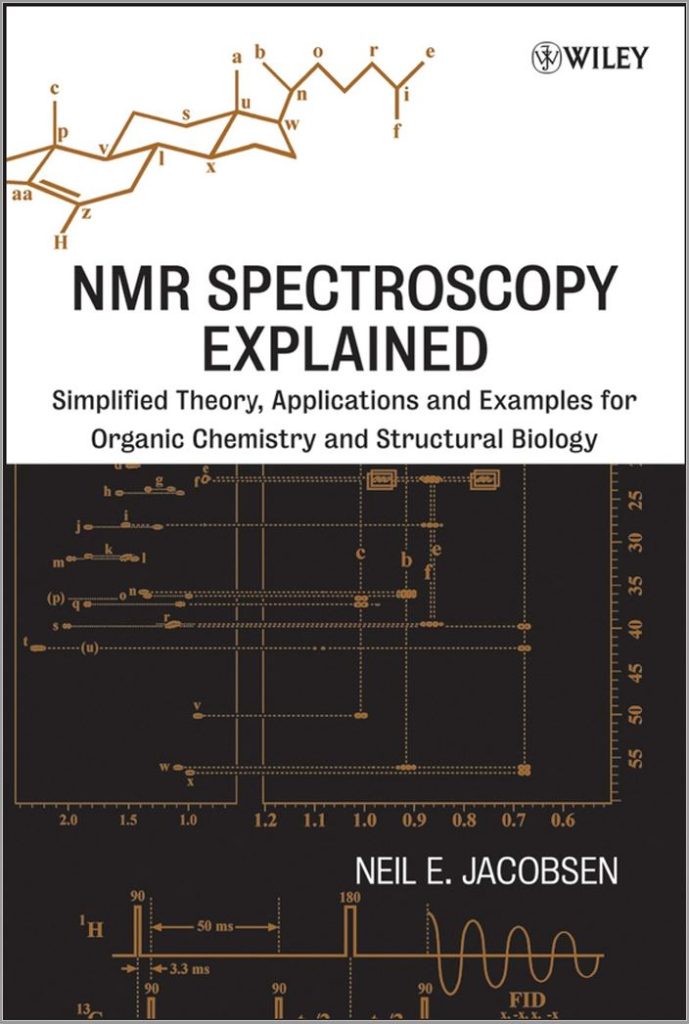
Free download NMR Spectroscopy Explained: Simplified Theory, Applications and Examples for Organic Chemistry and Structural Biology authored by Neil E. Jacobsen in pdf.
Nuclear magnetic resonance (NMR) is a technique for determining the structure of organic molecules and biomolecules in solution. The covalent structure (what atoms are bonded to what), the stereochemistry (relative orientation of groups in space), and the conformation (preferred bond rotations or folding in three dimensions) are available by techniques that measure direct distances (between hydrogens) and bond dihedral angles. Specific NMR signals can be identified and assigned to each hydrogen (and/or carbon, nitrogen) in the molecule.
NMR takes advantage of the magnetic properties of the nucleus to sense the proximity of electronegative atoms, double bonds, and other magnetic nuclei nearby in the molecular structure. About one half of a micromole of a pure molecule in 0.5 mL of solvent is required for this nondestructive test. Precise structural information down to each atom and bond in the molecule can be obtained, information rivaled only by X-ray crystallography.
Because the measurement can be made in aqueous solution, we can also study the effects of temperature, pH, and interactions with ligands and other biomolecules. Uniform labeling (13C, 15N) permits the study of large biomolecules, such as proteins and nucleic acids, up to 30 kD and beyond.
Contents
- Fundamentals of NMR Spectroscopy in Liquids
- Interpretation of Proton (1H) NMR Spectra
- NMR Hardware and Software
- Carbon-13 (13C) NMR Spectroscopy
- NMR Relaxation—Inversion-Recovery and the Nuclear Overhauser Effect (NOE)
- The Spin Echo and the Attached Proton Test (APT)
- Coherence Transfer: INEPT and DEPT
- Shaped Pulses, Pulsed Field Gradients, and Spin Locks: Selective 1D NOE and 1D TOCSY
- Two-Dimensional NMR Spectroscopy: HETCOR, COSY, and TOCSY
- Advanced NMR Theory: NOESY and DQF-COSY
- Inverse Heteronuclear 2D Experiments: HSQC, HMQC, and HMBC
- Biological NMR Spectroscopy
Free download NMR Spectroscopy Explained: Simplified Theory, Applications and Examples for Organic Chemistry and Structural Biology authored by Neil E. Jacobsen in pdf from following download links.
Sometime download link(s) is/are not visible on mobile devices, so if you face this issue, kindly do visit this page via laptop/desktop computer.
Password for Download Links: thespectroscopy.com
File Size: 10.8 MB | Pages: 685 | Download Instructions | Disclaimer
You may also like to free download:
- NMR Spectroscopy Basic Principles, Concepts and Applications in Chemistry (3rd edition) written by Harald Günther in pdf
- Modern Spectroscopy (4th edition) authored by J. Michael Hollas in pdf
- Spectroscopic Identification of Organic Compounds (8th edition) written by Robert M. Silverstein, Francis X. Webster, David J. Kiemle and David L. Bryce in pdf
Free download hundreds of best-selling chemistry books in pdf from HERE.
P.S: If the download link(s) is/are not working, kindly drop a comment below, so we’ll update the download link for you.
Happy Reading!
